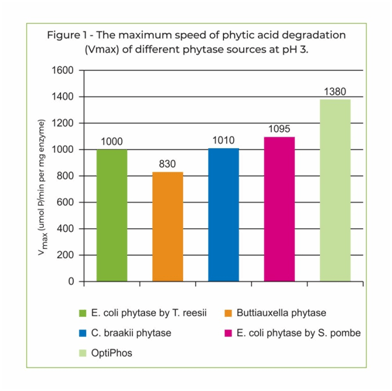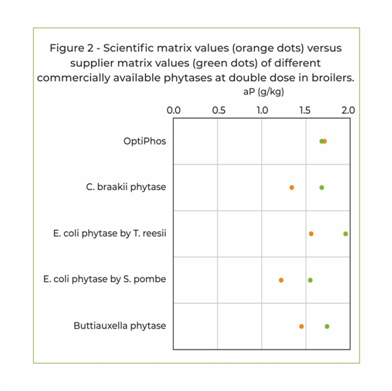What are the criteria to select a good phytase? Why select the fastest phytase? The importance of pH profile, pepsin resistance and speed (PPS) has shown to be critical to yield a fast phytase with reliable matrix values and superdosing properties.
The main reason for using an exogenous added phytase in feed is to liberate phosphorous (P), bound as phytate, in raw materials. This does not only lead to a lower feed cost by reducing the amount of added inorganic P, but also exerts a positive effect on performance by degradation of phytic acid, which is a known anti-nutritional factor in feed. In practical animal nutrition, a fast acting phytase has two major benefits. First of all, the higher the speed, the higher the P release from the phytate will be, and the less extra inorganic P needs to be added to the feed. Secondly, as phytate also exerts anti-nutritional properties linked to the binding of minerals, protein and even fatty acids, its faster destruction will thereby improve the digestibility of these nutrients and increase animal performance.
pH profile
It is well-known that phytic acid must be in solution for the exogenous phytase to be able to hydrolyse the phosphate groups. Phytic acid is largely soluble at pH levels below 4.0 (gizzard/stomach). However, at higher pH levels (as in the small intestine), it forms complexes with positively charged ions, like calcium. A good phytase therefore needs to be active in vivo in the upper digestive tract, throughout the complete acid pH range from pH 2 to 4.
Pepsin degradation
Pepsin is a protease present in the stomach/gizzard, responsi-ble for the degradation of proteins. As phytases are also proble for the degradation of proteins. As phytases are also proteins, its activity can be reduced by pepsin in the stomach area, the site at which it needs to work at its maximum. Research has shown that not all phytases are equally resistant against this degradation by pepsin, which means that the full effectivity of these phytases in the gizzard/stomach cannot be achieved, even though they might have the right pH profile.
Speed
The speed of hydrolysis of phytate by a phytase (the V max) is largely dependent on its pH profile and pepsin resistance and can be determined during in vitro enzymatic studies (the socalledMichaelisMenten kinetic studies).
In view of the short duration of feeding in the gastric region where the phytic acid is soluble and degradable, it is obvious that the Vmax of a phytase needs must be as high as possible and will influence the greater efficiency of phytase (Figure 1)

Scientifically proven P matrix values
In order to calculate how much the addition of inorganic P to feed can be reduced by a phytase, each phytase supplier provides their specific P matrix values. The higher these ma-trix-values are, the more interesting the phytase becomes for a nutritionist when calculating with best cost formulation. It is however of the utmost importance for the nutritionist to be able to 100% rely on the correctness of these supplier’s matrix values.
Trials done by independent research institutes, which are published in scientific peer reviewed journals, form an adequate and solid base for determining (and comparing) matrix values. These matrix values might be referred to as the ‘scientific matrix values’ and may be differentiated from the matrix values provided by the manufacturer, which we might call the ‘supplier matrix value’. Such research in this scientific literature over the period 2002-2017 for poultry, for instance, have revealed that most phytase suppliers, except OptiPhos, overestimated the matrix value by up to 25%, and might thereby lead to under performance of the animals (Figure 2)

Superdosing effects at double dose
Phytate is known to exert anti-nutritional aspects by binding minerals, proteins and even fatty acids, hindering their digestion and absorption by the animal. A fast working phytase like OptiPhos thereby will yield faster positive effects on improvement of performance, and will yield superdosing effects at double dose. Other phytases will need three to four times the normal dose to yield this effect.
Conclusion
It can be concluded that the intrinsic characteristics of a phytase source is determined for a large part by its in vivo activity and its speed of action. The choice of a phytase, ative at all relevant pH ranges, resistant to pepsin and showing a high speed of phytic acid degradation is therefore of the utmost importance to secure adequate and reliable P release from phytate. The better the phytase scores at these three points, the better and more reliable its P matrix values will be and the stronger the animal performance will be enhanced through superdosing.

To know more, please contact Huvepharma technical team
Huvepharma SEA (Pune) Pvt. Ltd.
42, ‘ Haridwar’, Road 2 A/B, Kalyani Nagar, Pune 411006 Customer Care Contact: +91 20 2665 4193 Email: salesindia@huvepharma.com Website: www.huvepharma.com























